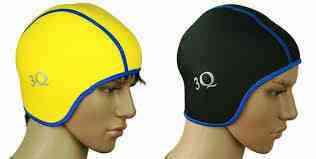Home › Diving Guide › Scuba Equipment › Wetsuits › Hoods
Scuba Dive Hoods and Neoprene Beanies
Dive hoods are designed for warmth and comfort while submerged. This category ranges from a thin lycra material to 7mm thick hoods.
Lycra dive hoods give little thermal protection and are used mainly for protection from the sun and anything in the water that should not touch your skin.
Beanies cover just the top of the head, back of the head and the ears. They have an adjustable strap under the chin to hold it in place.
A wet suit diving hood covers both the head and neck area and has a bib that can be tucked into the wet-suit at the neck. A Dry Suit diving Hood has a short bib that covers head and neck only, and is designed to cover only the neck seal of the dry suit.
Wet suits, and most dry suits worn by recreational divers, use neoprene wet suit hoods. You can choose from a variety of thicknesses in three basic types - bibbed hoods, non-bibbed hoods, and hooded vests.
Bibbed hoods flare into a broad flange, or 'bib' that you tuck under the neck of the wet suit jacket, or into a special collar on some dry suits. In wet suits, the bib creates a snug fit between your neck and the jacket, which minimizes water circulation.
In dry suits, the bib insulates the neck seal to eliminate a cold spot. Dry suits with insulated neck seals use non-bibbed hoods. Some divers use a hooded vest, which gives you all the benefits of a bibbed hood, plus extra insulation for your entire torso.
Divers who dive in cooler climates may not select a separate hood at all, but may prefer an exposure suit with a permanently attached hood.
You can find both wet suits and dry suits with this configuration. If you are wearing full-body exposure protection (wet suit or dry suit), but leave your head uncovered, you will lose approximately 75 percent of your body heat through your head.
 You may want a hood in warmer water but you definitely want to consider wearing a hood any time on a dive in water below 21 degrees Celsius.
You may want a hood in warmer water but you definitely want to consider wearing a hood any time on a dive in water below 21 degrees Celsius.
Dive Hood Tip - Women tend to get colder easier than men, because women tend to have more surface area (curves) then men do.
If a couple is traveling together it will almost always make more sense for the woman to have a warmer hood than a man would to the same destination at the same time of year.
If in doubt, always buy a hood slightly warmer than your needs because you can always remove a head cover, but if you are cold during a dive there is not much you can do except stop diving.
Caution - Tight-fitting Hoods
Select a hood that fits snugly, but not too tightly. A hood that is too tight can compress arteries in your neck (the carotids), which your brain perceives as high blood pressure and responds by signaling your heart to slow.
This can cause light-headedness and, if you keep the hood on, fainting and unconsciousness. A hood this tight will be uncomfortable so do not try to endure it and wear it anyway. Purchase your exposure suit hood on comfort and fit.
Beanies
A dive beanie is a practical addition to your scuba gear environmental protection system.
 It's ideal for protection from the sun, jellyfish and other stinging marine life combined with the added warmth that a beanie's provide.
It's ideal for protection from the sun, jellyfish and other stinging marine life combined with the added warmth that a beanie's provide.
They are usually constructed of Microprene, which is an ultra thin (about 1mm thickness) super stretchy neoprene that provides comfort and freedom of movement combined with warmth and durability.
Beanie's Tip - A Beanie has many benefits. It reduces hair pulling from the mask strap, prevents painful sunburn on sensitive scalps often caused by lack of head protection during dives, and beanies are perfect for adding warmth on repetitive dives and on those cooler night dives.
Neoprene Scuba Gear |> Gloves |> Booties |> Wetsuits |> Drysuits |